
Green Jay, Lower Rio Grande Valley TX
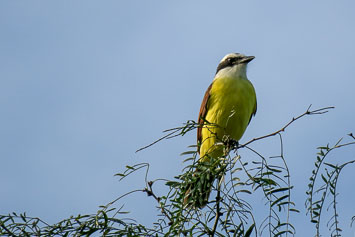
Great Kiskadee, Lower Rio Grande Valley TX
I had suggested a south Texas birding trip to Ed sometime last summer after our trip to North Dakota
but didn't think seriously about it until we happened to meet a woman named Mary Beth the day we
birded together in Portal last August. We ran into her while we were waiting for hummingbirds to
show up at the feeders at Dave Jasper's old place. Ed started talking with her and found out she
worked at the Alamo Inn, a B&B in the Rio Grande Valley that caters to birders. As they talked, I
began to see the trip as a real possibility. The Rio Grande Birding Festival would take place in
early November but the field trips were expensive, and might already be full anyway. For not much
more money we could hire a guide for just the two of us. The birds would mostly still be around the
week after the festival, and all those birders would already have located the rarities for us.
Still, it wasn't until a month ago that I confirmed that Ed was up to the trip and went ahead and
booked the travel.
Delia would join us for the weekend then Ed and I
would stay an additional four days. We would hire Mary Beth as a guide for the first two days to
show us around and help us learn the local birds than we would explore on our own the rest of the
time. Once we had confirmed the arrangements Mary Beth emailed me to request a list of birds we
were looking for. When I finally got around to putting together the list for her, I realized that
there were almost two dozen species in the valley that I had never seen. Even if I saw only half of
them, that would be more new life birds that I've seen in all three trips so far this summer put
together.
11/13/2015 South Texas day 1 - Salineņo, Bentsen 60 species
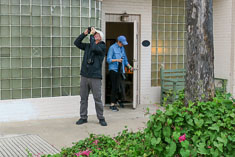
Ed and Delia, the Alamo Inn TX
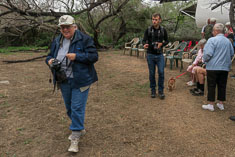
Mary Beth, Salineņo Rd TX
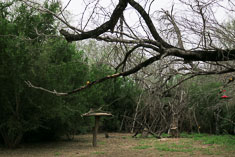
DeWind's Yard, Salineņo Rd TX
We had expected to arrive at the Alamo Inn in McAllen before sunset but our flight out of Seattle
was delayed so we missed the connection at Dallas-Fort Worth. Delia and I count steps so we used
the extended layover in Dallas to walk around the airport, getting in bonus steps by going the wrong
direction on the walkways and escalators. Getting all the way up a down escalator is no easy feat.
Keith graciously met us at the Inn when we finally arrived at 10:30 PM. He showed us around the
self-serve kitchen and our three room suite next door. Because a tour group was also staying at the
Inn they would be serving a cooked breakfast at 6:30AM. We signed up too.
After too short a night, Ed and I made coffee then we all trooped over to the combination store and
dining room at the Inn. Breakfast was delicious - whole-grain bread, bright yellow scrambled eggs
from someone's backyard chickens, bacon and sausage and grits and fruit - what a great way to start
our first day.
Mary Beth met us at seven but we weren't ready until about 7:30, and then we spent another 15
minutes chasing down a Tropical Kingbird across the street. It was our first south Texas specialty
but not as special for me since I saw one just two weeks ago in Neah Bay, Washington. Given our
interest in photography she suggested Salineņo Rd for our first stop. A couple named De Wind (I
think) maintains a winter bird feeding station at the end of Salineņo Rd down by the Rio Grande a
few miles southeast of the Falcon dam. That would be our best chance for Audubon's oriole, Mary
Beth told us, and good for Altamira Oriole, Long-billed Thrasher, Clay-colored Thrush and Ringed
Kingfisher, all species on my target list. And we'd get good pictures, she assured us.
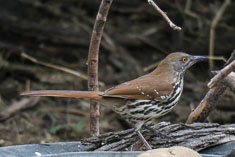
Long-billed Thrasher, Salineņo Rd TX
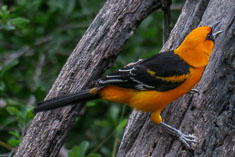
Altamira Oriole, Salineņo Rd TX

Audubon's Oriole, Salineņo Rd TX
She was right about that. We had great close-up views of the two orioles and the thrasher (all
three life birds for me) and of several other valley specialties. We would see (and hear) Gila
Woodpeckers, Green Jays and Great Kiskadees almost everywhere we went but rarely as close-up as we
did in
the De Wind's
back yard L+. The next three species we later saw at Bentsen State Park as well,
which happened to be where I had first seen all three 38 years ago.

Gila Woodpecker, Salineņo Rd TX

Green Jay, Salineņo Rd TX
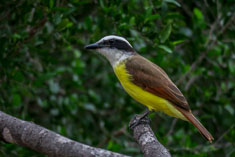
Great Kiskadee Flycatcher, Salineņo Rd TX
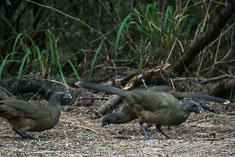
Plain Chachalacas, Salineņo Rd TX
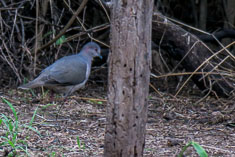
White-tipped Dove, Salineņo Rd TX
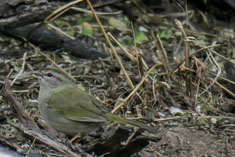
Olive Sparrow, Salineņo Rd TX
Though we peered up and down the river we did not spot any Ringed Kingfishers. We also missed the
Red-billed Pigeons which are reported to roost on the island visible upriver. On the other hand we
spotted a Zone-tailed Hawk, one of only two for the trip, soaring over the far bank of the river
(and therefore over Mexico) and we stumbled across a late Lesser Nighthawk roosting in the mesquite
just upstream. The Nighthawk is a Lesser because it's wingtips barely reach the tip of its tail
when it is perched, characteristically lengthwise, on a tree limb. We would have spent more time in
the mesquite forest but it had burned last year so there was no undergrowth and therefore few birds.

Rio Grande at Salineņo
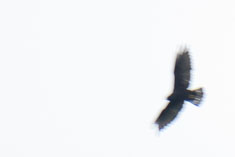
Zone-tailed Hawk, Salineņo Rd TX

Lesser Nighthawk, Salineņo Rd TX
Three men had parked their pickup truck down by the river and were fishing. Though they did not
speak much English, they were able to explain that they were fishing for Alligator Gar and they
spread their arms wide to show us how big the fish could get. They had not caught any. Ed
explained, unnecessarily perhaps, that we were birdwatching. Excited to show off their knowledge of
birds, they pointed out the cormorants downstream and a heron fishing upriver. They had not seen
any kingfishers as far as we could determine.
Though the weather had been dry at Salineņo, a factor in our choice to go there first, it was
raining as we came back to Rio Grande city. We stopped at Church's Fried Chicken so Mary Beth could
get some lunch and while we ate in our fogged-up car, a small flock of Cave Swallows was foraging
overhead. I don't think I ever saw one well enough to distinguish it from a Cliff Swallow but both
Mary Beth and eBird agreed that Cliff Swallows were much more likely.
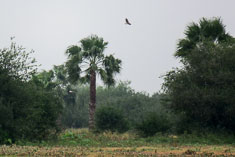
White-tailed Hawk and Sabal palms, Bentsen SP TX
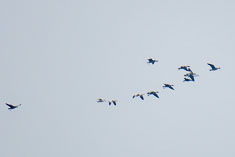
Snow Geese with White-fronted Geese, Bentsen SP TX
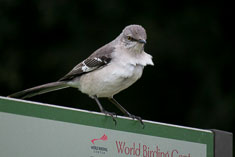
Northern Mockingbird, Bentsen-Rio Grande Valley SP TX
The weather dried out again as we approached
Bentsen Rio Grande Valley State Park L+. Just outside the park I spotted a
White-tailed Kite diving on another hawk which turned out to be my first White-tailed Hawk. To me
it looked like a dark phase Harlan's - almost completely dark brown above and below with pale flight
feathers and a pale brown tail - but there were three or four of them and on closer inspection we
could pick out the small white patch on the chest which made them juvenile White-tails.
We saw several more in the park including a brief view of an adult overhead. No photo though; I
didn't get on it in time. I only got the geese because I already had the camera out after
photographing the Mockingbird. That was a very patient bird. It waited while I leaned over,
propped my forearms on my knees to grab the camera (hanging from my neck) with both hands, find and
press the power button with my ring finger, jerk (as in weightlifting) the camera up to my face,
position my index finger sideways on the shutter button, aim, focus and shoot. With all that, my
first three shots were out of focus but I finally got a sharp one. Although not the most common
bird of the trip (that would be the Great-tailed grackle), mockingbirds were both the most
ubiquitous and most loquacious. Over and over again we would hear another loud and exotic-sounding
call and have to remind ourselves, "Oh right, that's a mockingbird." Mary Beth was very helpful with
the calls. She pretty much knew them all and saved us a lot of time in not having to track them all
down.

Ruby-throated Hummingbird, Bentsen-Rio Grande SP TX

Buff-bellied Hummingbird, Bentsen-Rio Grande Valley SP TX
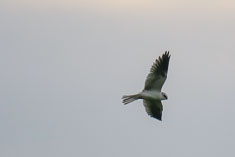
White-tailed Kite, Bentsen-Rio Grande Valley SP TX
We found both Ruby-throated and Buff-bellied hummingbirds in the garden at the Benson State Park
headquarters. The Buff-bellied was my fifth and last life bird for the day. We had hoped to see an
Eastern Screech Owl in one of the gnarled trees beyond the restrooms near the Kingfisher overlook
but it wasn't there. Nor were there any kingfishers at the overlook. The most exciting birds in
the area were two American Robins that Mary Beth picked up by their calls. They may be rare in the
valley but I still didn't couldn't be bothered to take their picture.
11/14/2015 South Texas day 2 - Anzalduas, Estero Llano Grande 105 species, 121 for the trip

Ed, Mary Beth and Delia, Anzalduas County Park TX
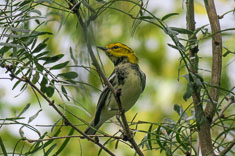
Black-throated Green warbler, Anzalduas County Park TX
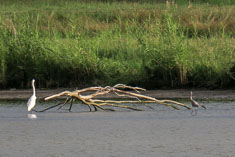
Great and Reddish Egrets, Anzalduas County Park TX
With Mary Beth as our guide again we drove over to
Anzalduas County Park L+ this morning in search of a
previously reported Greater Peewee which, despite being a summer breeder in southeastern Arizona,
would be a life bird for Ed and Delia. We were also hoping for a Hooked-billed Kite. We did not
find the kite but we did see our only Broad-winged Hawk of the trip, along with a Swainson's, a
Red-tail, two Gray, three Harris's, two Cooper's and a Sharp-shinned Hawk. We also found the
peewee.
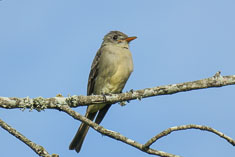
Greater Peewee, Anzalduas County Park TX
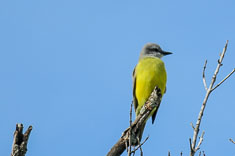
Tropical Kingbird, Anzalduas County Park TX
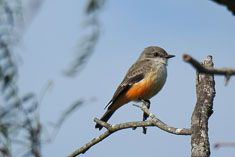
Vermilion Flycatcher, Anzalduas County Park TX
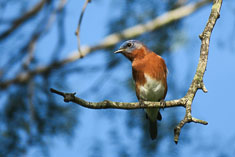
Eastern Bluebird, Anzalduas County Park TX
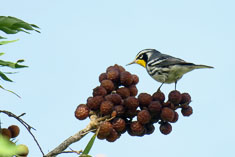
Yellow-throated warbler, Anzalduas County Park TX
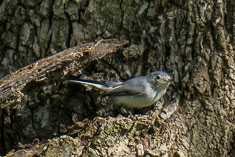
Blue-gray Gnatcatcher, Anzalduas County Park TX
Among the flocks of small birds in the trees we found five species of warblers. We ended up with
57 species. I was surprised to get such a high count since the park basically consists of 20
acres of mowed lawn with scattered trees. The park fronts on a bend of the Rio Grande immediately
above Anzalduas Dam. There are good-sized patches of riparian and Mesquite scrub habitat to the
north and south but access to those areas is restricted. Border patrol agents and police were
everywhere in evidence and all the local access roads are off-limits to the public.
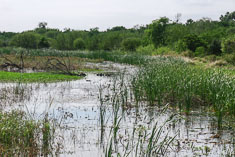
Ibis Pond from visitors center, Estero Llano Grande SP TX
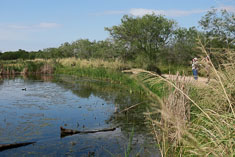
Dowitcher Pond, Estero Llano Grande SP TX
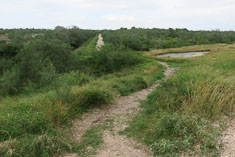
View north toward Alligator Lake (hidden) from Levee
Giving up on the Hook-billed kite, we drove over to
Estero Llano Grande State Park L+ to find a previously staked-out
Common Pauraque and Groove-billed Ani and to try again for an Eastern Screech Owl. All three would
be life birds for me. The Groove-billed Ani in particular has intrigued me ever since I saw its
picture in my first bird book more than 40 years ago. Today I saw it, and the other two species
as well. We had a variety of ducks and a nice collection of waders for a total of 61 species.
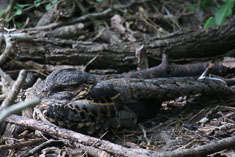
Common Pauraque, Estero Llano Grande SP TX

Groove-billed Ani, Estero Llano Grande SP TX
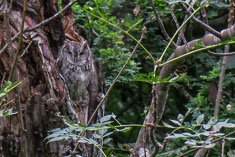
Eastern Screech Owl, Estero Llano Grande SP TX
The Pauraque has apparently roosted in the same area (maybe even the same spot) a few feet off the
trail by Alligator Lake for several years now. I doubt we would have seen it had not Mary Beth
known exactly where it was. The Anis were flopping around in thickets along the levee as reported
on eBird. The park host, Huck Hutchens, showed us the Eastern Screech Owl roosting in a snag at the
far end of the Tropical Zone drive.
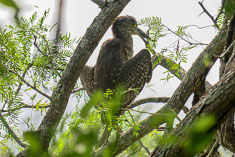
Juvenile Black-crowned Night Heron, Estero Llano Grande SP TX

Yellow-crowned Night Heron, Estero Llano Grande SP TX
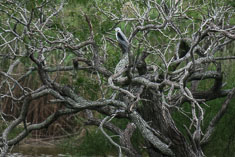
White-tailed Kite, Estero Llano Grande SP TX

Black-bellied Whistling Duck, Estero Llano Grande SP TX

Least Grebe, Estero Llano Grande SP TX
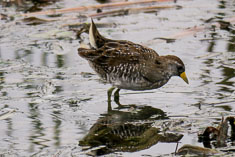
Sora, Estero Llano Grande SP TX
The Night Herons were roosting in trees along Alligator Lake. Though the Black-crowned occurs in
Washington I hadn't seen a Yellow-crowned since the last visit to Texas 38 years ago. Appropriately
there was a big alligator also resting on the shore of Alligator Lake. The kite was on the other
side of the levee, along with egrets, more herons and even Roseate Spoonbills but all of the
waterbirds were too far away for photos. I fared better with the waterbirds in the Ibis Pond as we
were returning to the visitor center. Remarkably there were five different Soras wading around out
in the open between the cattails. That is more Soras than I've laid eyes on altogether in my life
so far. The light was not ideal for photos but I tried anyhow. The several Black-bellied Whistling
Ducks present gave me my first good look at the species but we didn't find the Fulvous Whistling
Ducks reported a couple of days ago.
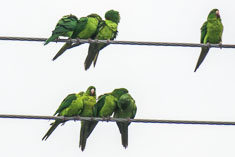
Green Parakeets, McAllen TX
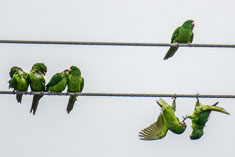
Green Parakeets, McAllen TX

Green Parakeets foraging in oak, McAllen TX
Green parakeets are sufficiently well-established in the area to be officially countable. Mary Beth
sees or hears them every few days around the Alamo Inn. Late this afternoon she took us up
North 10th Street in
McAllen L+ to look for the flock that roosts in the area. We found them gathered on the
wires in the neighborhood of Dove Avenue, a raucous crowd of about 170 of them about an hour before
dusk. We pulled into a parking lot, got out and took photos. They obliged by flying down to a
little oak tree next to our car and foraging for acorns. The experience of seeing those sociable
birds up close, and Mary Beth's assurance that these were most likely wild birds, completely
redeemed their reputation in Ed's eyes.
I forgot to mention that we started the day with parakeets too - Monk Parakeets nesting in the town
of Hidalgo. I didn't get out of the car in time to get photos of them. Both parakeet species were life
birds which gave me another five for the day. Altogether we had 105 species today and a cumulative
total so far of 121 for the trip. Ed and I have a goal to beat 175, the number of species we saw on
our Michigan trip last year. We don't think we'll succeed.
11/15/2015 South Texas day 3 - Santa Ana, Bentsen 74 species, 139 for the trip
Since we didn't have much time this morning before having to get to the airport to put Delia
on a plane back to
Seattle, we decided to try
Santa Ana NWR L+ just eight miles south of the Alamo Inn. We thought we
might find a Hook-billed Kite there. That turned out to be a little too optimistic, but we did see
our only Clay-colored Thrush of the trip, a good view near the parking lot along the Malachite trail
but unfortunately too brief for a photo. It was an intriguing bird, very much like a robin in
appearance and behavior except it was uniformly neutral brown above and slightly lighter brown
below.
We set out together to take the Pintail Lakes trail but realized when we reached the lakes that we
needed a scope so I
went back to get it. While I
was gone Ed and Delia identified a Ringed Kingfisher in a distant snag but unfortunately it flew
before we could get the scope on it.

Delia and Ed, Santa Ana NWR TX

Black-necked Stilts, Santa Ana NWR TX
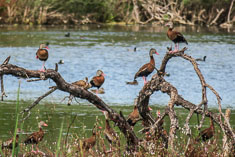
Black-bellied Whistling Ducks, Santa Ana NWR TX
The first lake hosted a flock of Black-necked Stilts and quite a few ducks,
mostly Gadwalls, Blue-winged Teal, Mottled Ducks and Northern Shovelers. We were more interested in
the snag full of Black-bellied Whistling-Ducks along the shore of the third lake. Back along the
first lake, waiting for the others to catch up, I heard two rails calling in the cattails along the
path. The first bird had a hoarse rapid "kek kek kek" call, usually in series of three but once or
twice in longer series. The second bird nearby made single hoarse "keeek" calls. All of the calls
were scratchier, lower and less distinct then the Virginia Rail calls that I am familiar with. They
more closely matched the Clapper Rail calls in Sibley but King Rail would be the expected rail in
the freshwater habitat of Santa Ana. In the end I had to leave them unidentified, but in retrospect
I suspect they actually were Virginia Rails.

Riparian forest, Santa Ana NWR TX
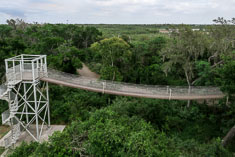
Hawk Tower, Santa Ana NWR TX
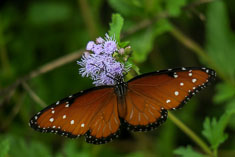
Monarch(?) Butterfly at the Alamo Inn, McAllen TX
Santa Ana at the only real riparian forest we saw on our trip, tall oaks and other trees festooned
with gray "Spanish Moss", with an understory of course tall grass. We only saw the river in a
couple of places and it was a good ten feet or more below our ground level. When we reached the
hawk watch tower Ed and Delia started to worry about getting to the airport in time so they walked
directly back to headquarters while I looped
around Willow Lakes. The lakes were mostly dry and there wasn't much bird activity around them. We
made it back to the Alamo Inn and on over to the airport in plenty of time.
In the afternoon Ed and I went back to Bentsen. I wanted to find the Tropical Parula which had been
hanging around the visitor center, so I stayed in the headquarters area while Ed wandered off down
the trails. Unable to use binoculars, I found the warbler search quite frustrating. The only small
birds I was able to identify in the one mixed flock I found were gnatcatchers and kingbirds and one
Orange-crowned Warbler. I didn't get any photos. Ed on the other hand got quite close to a Ringed
Kingfisher. I was jealous.
We ended up back at the Blue Onion for supper because the tamale place we want to go to was closed,
as was the Indian place in the same mall as the Blue Onion. On the way down North 23rd we pulled
over in a parking lot to search for restaurants on my phone. While we were sitting there we watched
a big white SUV hit a cyclist, knocking him into the adjacent lane. The SUV sped off before the
cyclist moved but though his bike was trashed, he was able to get up and walk his bike over
to his buddies in the parking lot. We were shocked at the hit and run but given our previous
experiences with Texas drivers, not surprised.
11/16/2015 South Texas day 4 - Choke Canyon 67 species, 155 for the trip
Among the birds I've been looking for this trip and haven't seen yet are two species which I
remember from my very first bird book, Singer's Golden Guide. One was an exotic-looking long-toed
wader called a Northern Jacana and the other was the other whistling duck, the Fulvous. Neither has
been consistently reported in eBird recently recently in any location other than Choke Canyon State
Park, three hours north of the Alamo Inn. I doubt we would have driven that far for either species
by itself, particularly given the likelihood that we would miss it, but with both species being
reported yesterday, we decided to go after them.

Sunrise, Encino TX
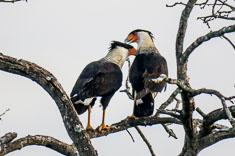
Crested Caracaras preening, Encino TX

Western Meadowlark, Encino TX
We stopped at sunrise at a rest area a few miles south of Encino and photographed a pair of each
other. We found both White-tailed and Red-tailed hawks in the same area, open mesquite grassland.
I photographed the Western Meadowlark along the frontage road in Encino.

Tamaulipan thornscrub, Sandia TX

Bewick's Wren, Sandia TX
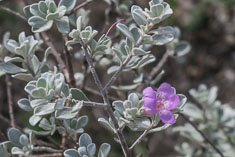
Texas Barometer Bush (Leucophyllum frutescens), Sandia TX
Continuing north, we crossed some dry hills near Sandia with
scrubby brushland (Tamaulipan thornscrub) L+ (about 20 miles south of Three
Rivers) and found Bewick's Wrens, Pyrrhuloxias and singing White-crowned Sparrows. The habitat was quite
different from anything we've seen in the valley.
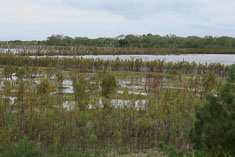
75 Acre Lake, Choke Canyon State Park TX
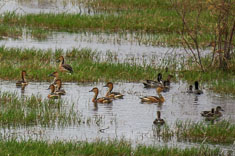
Fulvous Whistling Ducks, Northern Pintails, Blue-winged Teal
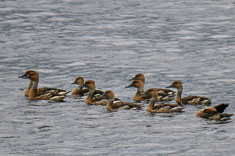
Fulvous Whistling Ducks, Choke Canyon State Park TX
Choke Canyon State Park L+
did not disappoint us. We found the whistling ducks right away; the 75 acre
lake was full of them. The Northern Jacana was tougher, in part because I looked very hard in the
wrong place. A couple from Corpus Christi was leaving just as we arrived. They had seen the Jacana
an hour earlier and directed me to look along the grassy far shore of the lake, or so I thought.
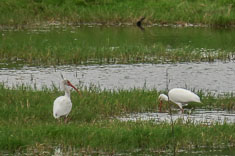
White Ibis, Choke Canyon State Park TX
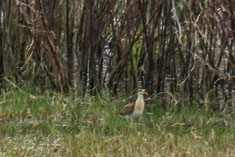
Northern Jacana, Choke Canyon State Park TX

Northern Jacana, Choke Canyon State Park TX
After I had scoped the far shore for an hour or so a young woman named Nicole arrived. She looked
familiar and when Ed struck up a conversation with her we found out that we had met two days earlier
at Anzalduas, looking for the peewee. It was she who found the Jacana for us.
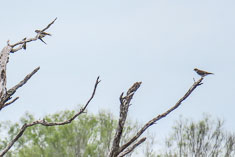
American Kestrel and Merlin, 75 Acre Lake TX
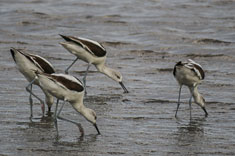
American Avocets, Bishop TX
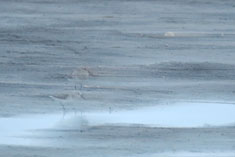
Western Sandpiper and Dunlin(?) at dusk
She had also heard about a Whooping Crane hanging out with a flock of Sandhill Cranes outside of
Bishop. A Mountain Plover had been reported in the area as well.
Bishop L+ was more or less on our way home so we followed her down
there but found only the Sandhill Cranes, flying overhead at sunset. With another hour of daylight
we might've been able to find the Mountain Plover. In gratitude for the Jacana (and because she was
good company) we took Nicole out for dinner at a local Mexican restaurant. She's doing a big year
and the Jacana was #519. It was #508 for me, but Nicole would go on to reach 574 by the end of the
year which put her in 15th place for the country in eBird. I would only make it to 528.
11/17/2015 South Texas day 5 - Brownsville, South Padre Island 97 species, 191 for the trip
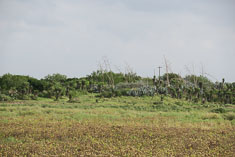
Grassland, Old Port Isabel Rd TX

White Pelicans, Old Port Isabel Rd TX

Reddish Egret, Old Port Isabel Rd TX
We hired Mary again to guide us on our trip to the coast. She found us Aplomado Falcons, sleek and
dashing birds, along
Old
Port Isabel Road L+. Though they were too far away for photos we had good
scope views. They reminded me of Hobbies in both plumage and conformation. A brisk breeze was
sweeping across the marshes, so perhaps the birds on the fence lines were too busy balancing to
worry about photographers. Whatever the reason, we had some good photo opportunities (other than
the falcons) both there and later in the day on South Padre Island.
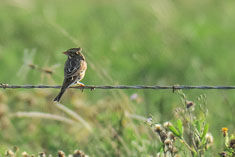
Savannah Sparrow, Old Port Isabel Rd TX

Eastern Meadowlark, Old Port Isabel Rd TXx
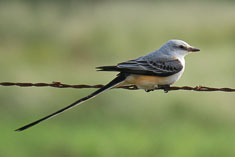
Scissor-tailed Flycatcher, Old Port Isabel Rd TX
Though we did not find the previously reported American oystercatchers at the
Shrimp Basin Bridge L+ on TX48, we did find Black Skimmers there,
my second life bird of the day.

Brown Pelicans, Laughing Gulls and Skimmer
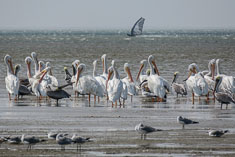
White and Brown Pelicans on WBC beach, South Padre Island TX
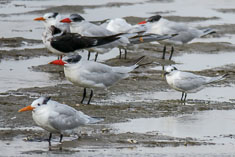
Black Skimmer with Caspian, Royal and Sandwich Terns
Continuing on to South Padre Island, Mary took us to
a small beach L+
just north of the World Birding Center convention center, which in turn is just north of the Audubon
Nature Center. The tide was partially out and the sand flat crisscrossed by ORV tracks.
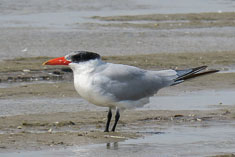
Caspian Tern, South Padre Island TX
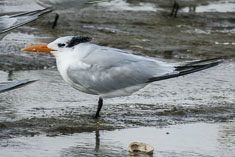
Royal Tern, South Padre Island TX
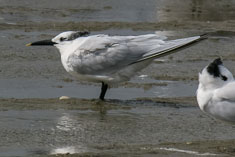
Sandwich Tern, South Padre Island TX

Forsters, Royal and Sandwich Terns, South Padre Island TX
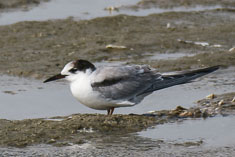
Common Tern (rare), South Padre Island TX

Black Skimmers, South Padre Island TX
It did not look like a promising spot for birds but we had 11 species of shorebirds and 9 species
of gulls and terns, plus pelicans, herons and even a Magnificent Frigatebird. Over Ed's objections,
we drove around on the sand flat like everyone else and thereby got nice close-up views for
photos.
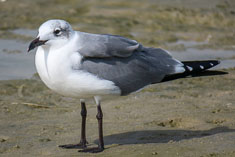
Laughing Gull, South Padre Island TX

Sanderling, Sandwich Tern and Laughing Gull, South Padre Island TX

Ruddy Turnstone, South Padre Island TX
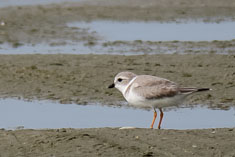
Piping Plover, South Padre Island TX
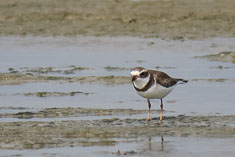
Semipalmated Plover, South Padre Island TX

Snowy Plover, South Padre Island TX
It would appear from these photos that Laughing Gulls come in long and short-legged versions. I do
not think that is actually true. In any case, it was a treat to see all three small plovers at the
same time.
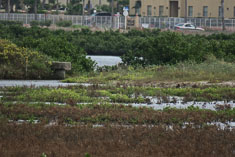
Audubon Nature Center marsh, South Padre Island TX
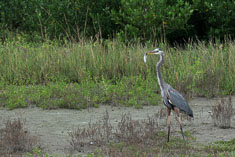
Great Blue Heron with fish, South Padre Island TX
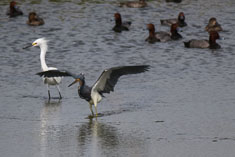
Tricolored Heron, Snowy Egret and Redheads
The
Audubon nature Center L+
was an amazing place to see waders - herons, egrets, ibises, spoonbills
and even my first ever Least Bittern (not pictured). During migration, it's a good spot for
songbirds too. We saw three species of warblers including a brief glimpse of a Northern Parula but
the fall migration is pretty much over. As the photos might imply, most of the large birds were
quite tame.
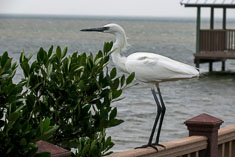
Reddish Egret, South Padre Island TX
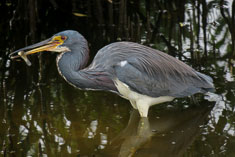
Tricolored Heron, South Padre Island TX
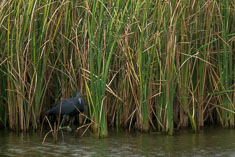
Little Blue Heron, South Padre Island TX

White Ibis, South Padre Island TX
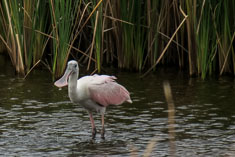
Roseate Spoonbill, South Padre Island TX

Roseate Spoonbill, South Padre Island TX
Mottled Ducks are the local version of Mallards. Gallinules and coots are close relatives. A few
alligators frequent the nature center marsh, including a mother with babies. The babies were no
more animated than Mom, but maybe it was just nap time.
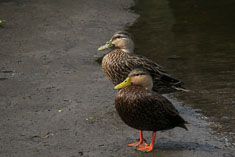
Mottled Ducks, South Padre Island TX
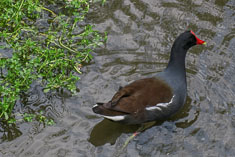
Common Gallinule, South Padre Island TX
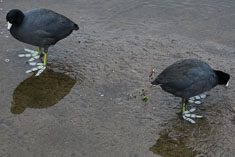
American Coots, South Padre Island TX

Alligator, South Padre Island TX
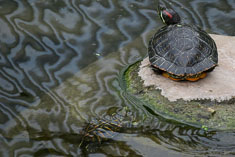
Turtles, South Padre Island TX
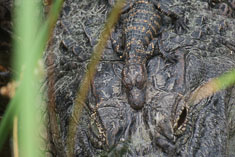
Baby Alligator, South Padre Island TX
Back at the shrimp bridge, a Spotted Sandpiper had showed up but the American oystercatchers had
not. The large flock of Laughing Gulls had been augmented by a few Franklins Gulls, distinguishable
by their dusky faces.
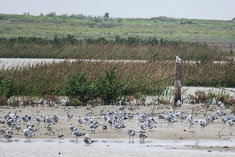
Laughing and Franklin's Gulls, Shrimp Basin Bridge TX
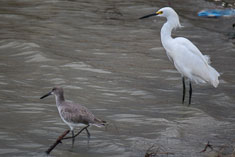
Willet and Snowy Egret, Shrimp Basin Bridge TX
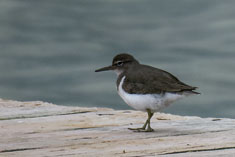
Spotted Sandpiper, Shrimp Basin Bridge TX
We wrapped up a long day of birding with a stop at
Oliveira Park L+ in Brownsville, where hundreds of
parrots stage in the eucalyptus trees at dusk before heading into the neighborhood to roost. A
couple of van loads of birdwatchers also showed up to see the parrots but there were plenty of birds
to go around. Although the White-fronted Parrots are not yet considered self-sustaining, the local
colony of Red-crowned Parrots may now be healthier than the original populations in Mexico from
which they were probably derived.

Ed and Mary watching parrots, Brownsville TX
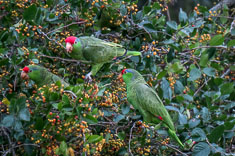
Red-crowned Parrots, Brownsville TX
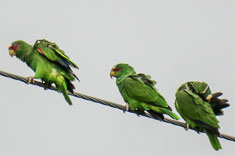
White-fronted Parrots, Brownsville TX
11/18/2015 South Texas day 6 - Anzalduas, Bentsen 83 species, 196 for the trip
On our own again, Ed and I decided to try again for a Hook-billed Kite at
Anzalduas L+. Our list of 65 species did not include the
Hook-billed Kite. The Greater Peewee was there, and the otherwise rare in the region House Finches.
I got photos of three of the six species of warblers present, all three presenting themselves one at
a time on the same tree trunk. I also decided to brave the chiggers and traipsed across the field
by the entrance, flushing Sprague's Pipits and both species of Meadowlark.
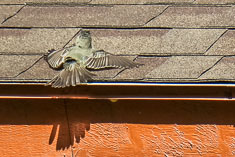
Greater Peewee sunning, Anzalduas County Park TX

Eastern Phoebe, Anzalduas County Park TX
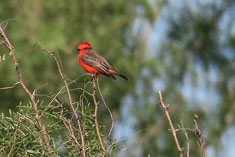
Vermilion Flycatcher, Anzalduas County Park TX
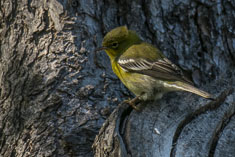
Pine Warbler, Anzalduas County Park TX
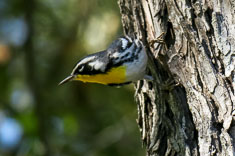
Yellow-throated Warbler, Anzalduas County Park TX
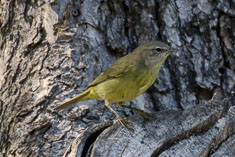
Orange-crowned Warbler, Anzalduas County Park TX
Things were pretty quiet at the visitor center at Bentsen State Park. I photographed an
uncharacteristically inconspicuous Mockingbird but wasn't able to get a picture of the brilliant
Hooded Oriole nearby. A Ruby-throated Hummingbird was hanging around the feeder and I heard a
Buff-bellied nearby but couldn't find it. The small bird flock with which the Tropical Parula had
last been reported was not around.
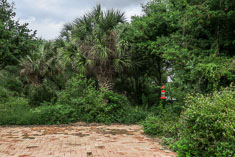
Visitors Center Garden, Bentsen State Park TX
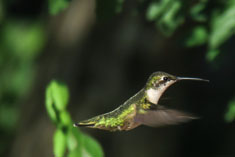
Ruby-throated Hummingbird, Bentsen State Park TX

Northern Mockingbird, Bentsen State Park TX
Hoping that the Ringed Kingfisher Ed saw on our previous visit would show up again at Kingfisher
Overlook, we headed out that way. Of course it was not there but I enjoyed taking photos at a
couple of the nearby feeding stations. The Wild Turkeys were new for the trip.
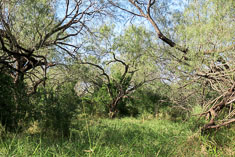
Mesquite woodland, Bentsen State Park TX
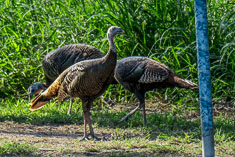
Wild Turkeys, Bentsen State Park TX
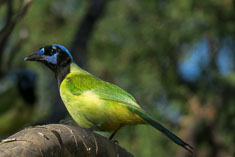
Green Jay, Bentsen State Park TX
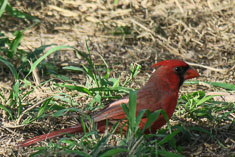
Northern Cardinal, Bentsen State Park TX

Great-tailed Grackle and Red-winged Blackbirds
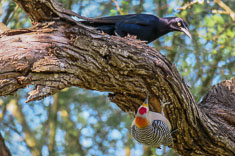
Great-tailed Grackle and Golden-fronted Woodpecker
Grey Hawks seemed to be everywhere. Ed noted that they appear to be the southwestern version of a
Broad-winged Hawk. I wanted to get a good close-up photo of an adult but had to settle for this
distant shot in a tree and a back-lit back view.
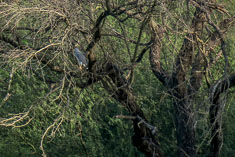
Gray Hawk in Mesquite, Bentsen State Park TX

Adult Gray Hawk, Bentsen State Park TX

Juvenile Gray Hawk, Bentsen State Park TX
A couple of guys on the shuttle bus had urged us not to miss the Hawk Watch Tower so we made the
trip out there. As we approached we flushed a Red-shouldered Hawk and as usual, I did not get a
good look at it. As soon as we got up on the tower a border patrol helicopter began circling around
the area quite low over the treetops. Annoyed by the noise we gave him the finger and he
immediately turned and made straight for us, veering off a hundred yards or so before he reached us,
but after that he left us alone. Other than Grey Hawks we didn't see much from the tower but agreed
we would recommend it nonetheless.

Ramp to hawk watch tower, Bentsen State Park TX
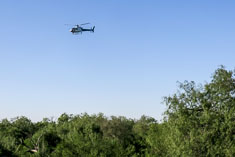
Border patrol helicopter, Bentsen State Park TX
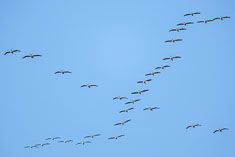
White pelicans in formation, Bentsen State Park TX
We caught the last shuttle back towards the visitors center and the driver graciously stopped so we
could all photograph an American kestrel. Ed continued on the shuttle but I got off and walked
because I wanted to swing by the Kingfisher Overlook one more time. The sun was getting low. Two
Great Horned Owls began to call. I photographed the two robins, locally rare, that we had seen on
our first visit. Still seeking Ed's Ringed Kingfisher I searched along the slough and it
was there. I got a photo for proof.
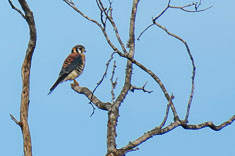
American kestrel, Bentsen State Park TX
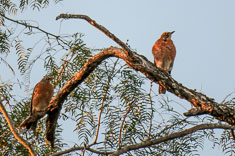
American robins, Bentsen State Park TX
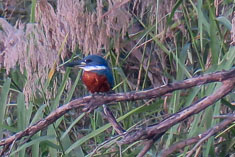
Ringed Kingfisher, Bentsen State Park TX
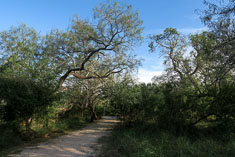
Mesquite woodland, Bentsen State Park
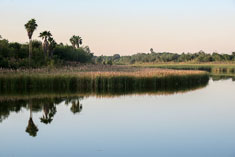
View from Kingfisher Overlook, Bentsen State Park TX
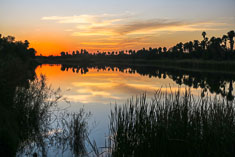
Sunset, Bentsen State Park TX
11/19/2015 South Texas day 7 - Estero Llano Grande, Mission Nature Park 55 species, 202 for the trip
On our last day we returned to Estero Llano Grande in pursuit of the Tropical Parula reported the day
before in the Tropical Zone section of the park. It was still there, foraging in the treetops with
a flock of other warblers, gnatcatchers and titmice. Our views weren't great but were sufficient to
identify it. We also relocated a previously-reported juvenile male Rose-breasted Grosbeak. Before we
left Ed found our first Nashville Warbler of the trip to bring our total species count up to 199.
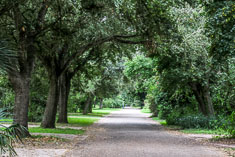
Tropical Zone, Estero Llano Grande SP TX

Tropical Zone, Estero Llano Grande SP TX

Tropical Zone, Estero Llano Grande SP TX

Rose-breasted Grosbeak, Estero Llano Grande SP TX

Rose-breasted Grosbeak, Estero Llano Grande SP TX

Tropical Parula, Estero Llano Grande SP TX
We met Huck on the way out and he showed us the Black Witch Moth, one of the largest moths found in
North America, though it is primarily tropical. The Mexican Bluewing I found while Ed was talking
with Huck. Ed had seen one earlier but this was my first. When we told Huck (or maybe it was one
of the other naturalists at the visitors center) that we were still looking for a Hook-billed Kite,
he suggested that we try the Mission Nature Park near the airport. The kites feed on the tree
snails which are common in the mesquite forest in the park.

White-winged Dove, Estero Llano Grande SP TX
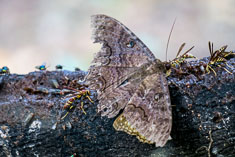
Black Witch Moth, Estero Llano Grande SP TX
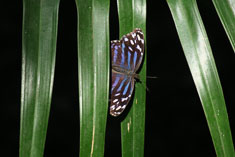
Mexican Bluewing Butterfly, Estero Llano Grande SP TX
The Mission Nature Park turned out to be a patch of mesquite woodland laced with mountain bike trails.
The mesquite wooodland extends more or less to both Bentsen-Rio Grande Valley State Park and to Anzalduas
Park so it's easy to see how the Hook-billed Kites could commute to the area to feed. We did not find
any kites but we did pick up three more trip birds to boost our total just barely over 200.
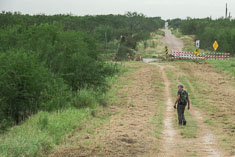
Ed, Mission Nature Park TX
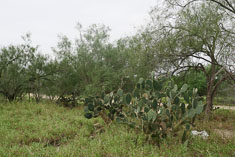
Prickly Pear and Mesquite, Mission Nature Park TX

Prickly Pear and Mesquite, Mission Nature Park TX
We followed a dike out from the parking lot, flushing a couple of Roadrunners. They seem to prefer
the dry mesquite woodland habitat. I heard a Bell's Vireo, recognizing its song from last July in
Big Bend National Park where it also frequents mesquite, but the bird was some distance away and we
didn't see it. We did see a Green Kingfisher, unintentionally chasing it along a grassy irrigation
channel. It was the best view I've had of the species. I also glimpsed a couple of sparrows but
didn't get a good look until we were almost back to the parking lot again. They were Cassin's
Sparrows, distinctively nondescript. I was too close to the one I saw well to get a photo.
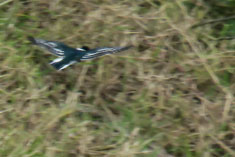
Green Kingfisher, Mission Nature Park TX
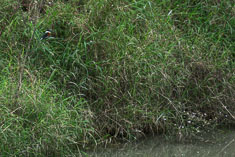
Green Kingfisher, Mission Nature Park TX
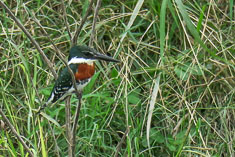
Green Kingfisher, Mission Nature Park TX
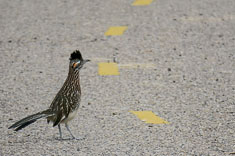
Greater Roadrunner, Mission Nature Park TX
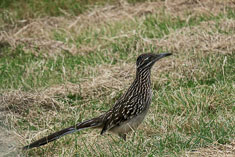
Greater Roadrunner, Mission Nature Park TX
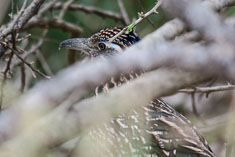
Greater Roadrunner, Mission Nature Park TX
That was not the case with the Cactus Wren; in fact I did not even know we had seen one until I was
reviewing my photos during the flight home. I had just assumed it was another Curve-billed Thrasher.
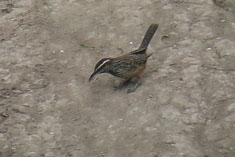
Cactus Wren
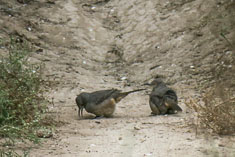
Curve-billed Thrashers, Mission Nature Park TX
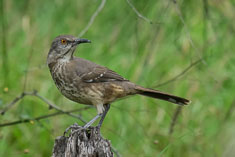
Curve-billed Thrasher, Mission Nature Park TX
I had to include a photo of a Harris Hawk, even though I obviously did not succeed in getting a good
one. We saw quite a few during our trip and they are beautiful birds. The Lincoln Sparrow and
Pyrrhuloxia were my last couple of sightings in the park and for the trip. The Pyrrhuloxia photo
was my first and only good view of that species. Anxious about getting to the airport in time, Ed
had already turned to go back to the car. After photographing the Pyrrhuloxia I decided to follow
suit, which was a good thing because it was a longer walk back to the car than I expected.

Harris Hawk, Mission Nature Park TX
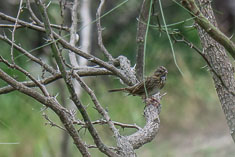
Lincoln's Sparrow, Mission Nature Park TX

Pyrrhuloxia and Tree Snails, Mission Nature Park TX
I ended the trip with 19 new life birds, exceeding my most optimistic projections. The only life
bird I expected to see but missed was the American Oystercatcher. The Hook-billed Kite was a big
miss as well but I hadn't expected to see it to begin with. For the trip I had 202 species, the
most I've ever seen on a single birding trip. The Alamo Inn was a perfect place to stay and I was
very happy with our decision to hire Mary Beth as our guide for three days. Ed was great company,
as always. His chronic pessimism and occasional anxiety alternately kept me grounded and provided
comic relief, but he is also excellent at spotting birds, better than he thinks he is at identifying
them by sound, and has enough common sense to realize that a timely end to birding today will enable
us to get out as early as we want to tomorrow - something I occasionally forget. Regarding the
photos, I took them all with a Canon G3X. It's remarkably good for a compact super-zoom and light
enough that I can still use it. I'm grateful for that.
Here's
a list of the 202 species of birds that
I saw or heard during the trip.
































































































































































